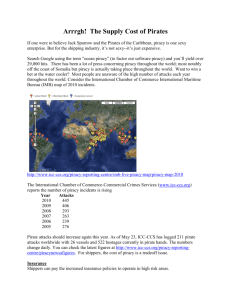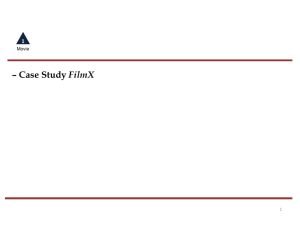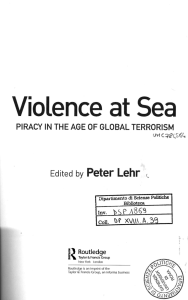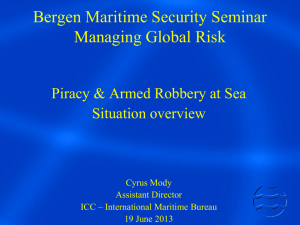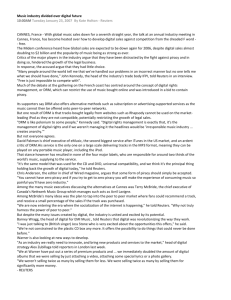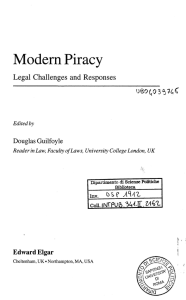Protecting Premium Content: White Paper
advertisement
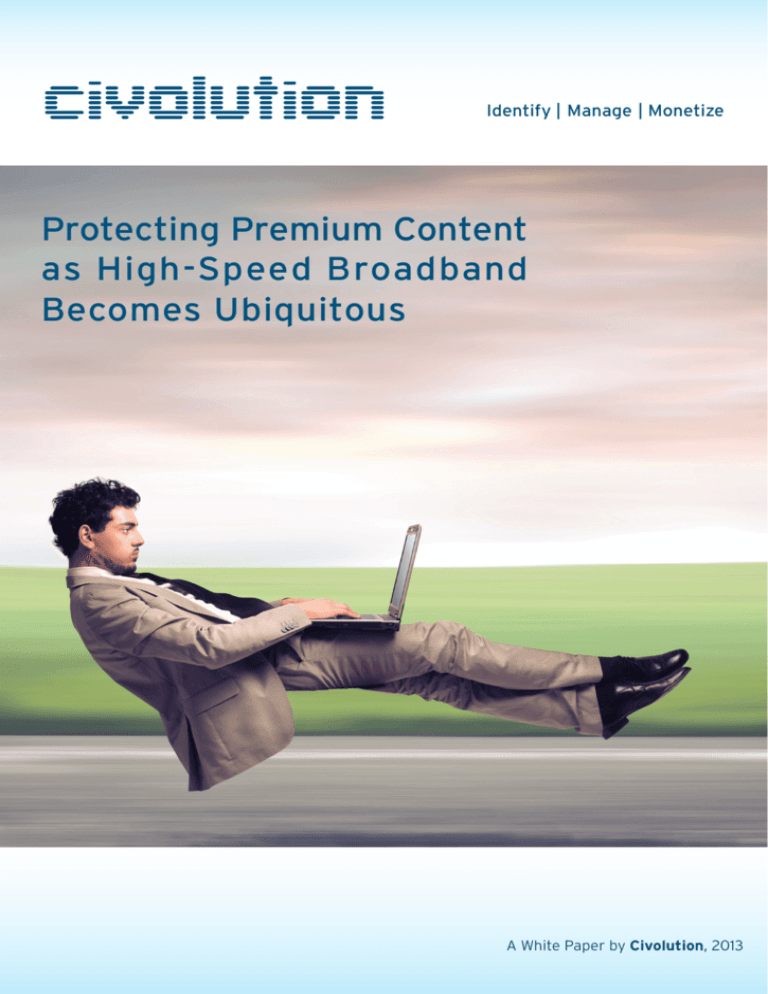
Identify | Manage | Monetize Protecting Premium Content as High-Speed Broadband Becomes Ubiquitous A White Paper by Civolution, 2013 Table of contents: 1. Executive Summary 3 4 6 4. Ubiquitous Hi-Speed Internet Has Fueled Piracy 6 6 6. DMCA Takedown Notices : Protection Beyond Encryption 8 7. ‘Game of Thrones’ Dubious Honor of Being ‘Most-Pirated Show’ 8 8. Scarcity is the Basis of the Pay TV Business 9 9. Better Content Protection Can Sometimes Mean Lower Quality of Service 9 10. Protecting Content Beyond Decryption with Forensic Watermarking 10 11. The Future of Content Security 13 12. Civolution’s NexGuard Track Record 14 13. Conclusion 14 2. The Growing Demand for Pay-TV Content 3. The Price of Piracy 5. Higher Quality Content Makes Pirating Simpler A White Paper by Civolution, 2013 - 2 1. Executive Summary Ubiquitous access to high-speed Internet services is transforming the global pay-TV and over-the-top environment as the lines between pay-TV providers and owners of premium content blur. Opportunities to develop new services and revenue streams abound, as content owners now can, if they choose, deliver their premium assets directly to the consumer. Increased demand for content by viewers eager to consume it has created a wealth of opportunities for service providers as well, allowing them to leverage decades of experience in delivering a wide array of content. This paper looks at the challenge presented in protecting premium content from piracy, especially as operators and content owners expand distribution to the open, unmanaged Internet, an environment that many content owners are as fearful of as they are hopeful. If TV Everywhere deployments are to become truly universal and over-the-top distribution of even the most-valuable assets is a goal, then protection of content, and the ability to track it and its origins, becomes critical. Forensic watermarking, especially when combined with Internet monitoring and fraud detection, is well suited to stop content piracy at its source, and efficiently and unmistakably identifying the first source of leaked content without negatively impacting the viewer experience. A White Paper by Civolution, 2013 - 3 2. The Growing Demand for Pay-TV Content Multiscreen services like TV Everywhere and other premium over-the-top services have grown at a phenomenal pace, driven in part by consumer demand and by the expanding availability of affordable high-speed Internet. In the United States, Akamai1’s most recent State of the Internet report showed average Internet speeds now exceed 7.4 Mbps. Globally, average connection speeds increased more than 25 percent, with average peak connection speeds increasing 35% to more than 16 Mbps. The quality of content delivery has also improved. This summer’s approval of the h.265 video format will help guarantee that HD delivery of content becomes ubiquitous among over-the-top video distributors. Along with HD, content owners—and consumers—are also eagerly anticipating the arrival of Ultra HD, with image sizes four times larger than Full HD. New technology to deliver extremely high-quality content with reduced bandwidth is developing in other sectors of the industry as well. Netflix, for example, recently said its highest-quality deliveries now average only one-third of a subscriber’s bandwidth, compared to 2007, when its maximum stream was larger than the average user’s bandwidth. 1 Akamai Fourth Quarter 2012 State of the Internet Increasing Bandwidth is Opening New Doors to Content Delivery That ubiquity of speed across the Internet has had a huge role in the deployment of TV Everywhere and overthe-top services. It is generally estimated that at least 80 percent of adult broadband users watch some video over the Internet. Sandvine, which closely follows broadband activity, said that 68.2% of all North American downstream traffic in the first half of 2013 consisted of real-time entertainment, and noted that Netflix traffic made up more than 32% of that.2 In North America, more than 90% of households that subscribe to pay-TV services are expected to have access to a TV Everywhere service by the end of 2013.3 Still, adoption has been slower than expected; the need for multiple authentications by consumers, as well as complex DRM demands for operators have been particular pain points. Both are hopefully in the process of being resolved. Regardless, customers appear eager to access content on any device, at anytime and, increasingly, anywhere. That’s making TV Everywhere a must-have product, with operators looking to it as both a tool to help reduce churn and one more way to add incremental revenue to the bottom line. 2 3 Sandvine’s Global Internet Phenomena Report, 2013 ABI Research: TV Everywhere Grows High-Value Live Linear Content is Coming to the Internet For the past two years, TV Everywhere has focused primarily on delivering on-demand video content. Now, led by content owners Disney and CNN, that has begun to change. Disney started streaming live linear Disney, ESPN and ABC content to pay-TV subscribers in several U.S. markets, with plans to deliver live content to more than 200 markets in the coming years. CNN, meanwhile, is delivering live news to multiple screens in multiple markets. Research by the Diffusion Group shows that 80% of respondents to a recent poll rate TV Everywhere as a valuable part of their pay-TV service, and 64% said real-time TV was “very valuable.”4 Additionally, nearly 50% said they would “definitely” use a live linear multi-screen service if it were offered by their service provider. “Adding live linear access to their delivery options is not only technologically feasible; it would be widely used and increase the perceived value of the subscription (something operators definitely need as prices continue to increase and OTT becomes more competitive)” said Michael Greeson, founding partner at TDG. 4 TDG: Bringing Multiscreen Live Linear Programming to Operator ‘TV Everywhere A White Paper by Civolution, 2013 - 4 Customers appear eager to access content on any device, at anytime and, increasingly, anywhere. A White Paper by Civolution, 2013 - 5 3. The Price of Piracy As attractive as TV Everywhere is, deployment of the service brings with it a potential—and huge—concern for content owners and service providers: rampant piracy. Depending on the source, the cost of piracy is estimated to range from $500 million a year to more than $6 billion annually in the United States alone. According to a recent report from the Motion Picture Association (MPA), when including losses from both theft over the Internet and from DVDs, the industry’s global losses may exceed $18.2 billion annually.5 Of those, the MPA said some 80% occurred overseas. A 2011 report commissioned by NBCUniversal said more than 22% of all global Internet bandwidth is used for online piracy; it estimated 67% of digital piracy sites are hosted in the U.S. and Western Europe. 5 The Motion Picture Association: The Cost of Movie Piracy Pirates Have Seen Their Own Technology Advances The problem is that, like the technology that delivers content across the Internet, piracy itself has been undergoing its own technology evolution. Before the explosion of broadband, video to the home was delivered in a one-way, closed and highly controlled environment that was accessed by a subscriber using a proprietary set-top box (STB). The STB was supplied to customers by operators, and was, essentially, a terminal for receiving content, with no user access and closed to software uploads. This basic transit mode has always been considered safe, difficult to hack (although not impossible), and security was reasonably easy to renew—at a cost. Piracy generally was relegated to poor copies made by hackers capturing the SD output of a STB in analog format, key (control word) sharing, or STB cloning. In the pre-broadband era, the security in place at the time, conditional-access software (CAS) and digital-rights management (DRM) systems, generally provided adequate protection. 4. Ubiquitous Hi-Speed Internet Has Fueled Piracy While closed systems remain the predominant method used in the pay-TV industry today, especially by cable and satellite operators, the allure of IP delivery, like that employed by telcos, is strong. IP delivery allows cable companies to offer better services to residential and business customers, and to deliver traffic reliably and with increased flexibility and multi-screen experience. But while that bi-directional system has numerous benefits, bringing more consumer-owned and managed devices into the loop makes preventing pirating more difficult, especially since many of them run on open operating systems. Unfaithful subscribers can now run their own software next to that being used by service providers, easily capturing content and distributing high-quality copies. Live content is equally at risk of being recorded and streamed, even with new commercials inserted into the original content, almost indistinguishable from the legal stream. 5. Increase of Video Quality Induces Higher Quality Pirated Copies As more Ultra HD content comes to market, capturing it and distributing HD copies from it becomes simpler. While CAS and DRM help guarantee only authorized subscribers have access to pay-TV content, hackers increasingly are able to work around those systems, creating a massive challenge to the content protection industry and escalating the potential level of losses by content owners. With the growing popularity of TV Everywhere, as well as the propensity of premium content owners to deliver more content directly to consumers over-the-top to a diversity of devices, there’s a painfully obvious need for additional security. A White Paper by Civolution, 2013 - 6 Unfaithful subscribers can now run their own software next to that being used by service providers, easily capturing content and distributing high-quality copies. A White Paper by Civolution, 2013 - 7 6. DMCA Takedown Notices: Protection Beyond Encryption The cost of piracy, obviously, is not lost on content owners, programmers and pay-TV operators. Starting in 1998, with the advent of the Digital Millennial Copyright Act, the digital media industry began closely monitoring the Internet, searching for illegal content. The process has become an integral piece of the anti-piracy battle. Monitoring services can quickly locate stolen content, and “take-down notices,” which demand content be removed from the Internet, are sent out to ISPs and OSPs, which quickly act. But, while takedown notices usually generate prompt action, they can’t stop sharing sites that won’t respond. 7. ‘Game of Thrones’ Dubious Honor of Being ‘Most-Pirated Show’ Part of the issue is that the general public sees little wrong with piracy, as long as assets being accessed are for personal use. Almost 70% of respondents to a study by Denmark-based Rockwool Foundation Research Unit said downloading illicit material from the Internet was acceptable. The recent season premiere, for example, of HBO’s “Game of Thrones” saw more than one million users illegally download copies of the show within hours of it being aired. That illegal sharing went on for days and experts said the episode was downloaded by more than 5.2 million users, an audience almost as large as the 5.5 million viewers who paid to see the content! The cost of being the most pirated show ever? In excess of $170.7 million in lost revenue to HBO. Some 90%of the torrent downloads of the episode occurred outside of the U.S., with Australia’s 10.1%being the largest offenders. “Game of Thrones” is one example of a premium cable channel losing revenue. But pirates attack more than just cable networks. In 2012, for example, the Top 10 most-pirated shows included five from major broadcast networks, and two from ad-supported AMC Network. (See chart below). Online video platform Ooyala estimated that the cost for an entire season of illegal downloading could exceed $1.5 billion for those shows alone. It is to be noted that the global piracy impact is not just about domestic revenues related to subscription, but also to revenues from international distribution. If content is freely available on the net, international purchasers will not pay a premium for that content. Estimates for Other Shows that Lost Big to Piracy in 2012 Show Dexter The Big Bang Theory How I Met Your Mother Breaking Bad The Walking Dead Homeland House Fringe Revolution Network Showtime CBS CBS AMC Network AMC Network Showtime Fox Fox NBC Illegal Downloads 3.9 million 3.2 million 3.0 million 2.58 million 2.58 million 2.55 million 2.4 million 2.4 million 2.28 million Revenue Lost $138.1 million. $229.6 million. $212.4 million. $100.3 million. $99.1 million. $86.1 million. $153.9 million. $150 million. $140.1 million. A White Paper by Civolution, 2013 - 8 Piracy is a Global Problem Content owners in the U.S. are not alone in their struggle to keep their assets safe; it’s a global problem. The Netherlands, for instance, has one of the most robust VOD markets in the world, according to the Film Research Foundation (FRF). While the market is small (the population is just 16 million), the number of viewers has doubled to nearly two million in just three years and generated more than $96 million in revenue in 2012. The FRF, however, said revenue growth has slowed despite the increased viewing. While VOD makes up 25% of home entertainment revenue, growth has slowed from 62% in 2011 to 41% in 2012. The slowdown, according to analysts, is likely linked to piracy. 8. Scarcity is the Basis of the Pay TV Business As TV Everywhere and over-the-top rollouts have riveted consumer interest and fed demand for more programming, content owners and studios have maintained that newer content generally is more valuable than catalog content. In other words, scarcity of content drives up its price. A theatrical release, after all, makes its most money the first weekend it plays. Pirates know that, too, which is why, for example, “Games of Thrones” saw its greatest replication on the night it was aired. Sporting Events and Live Concerts Have Immediate Appeal For sporting and other live events, the stakes are equally as high, and the danger of piracy is very serious. Major events like the Super Bowl, World Cup or live concerts all have a small window of extreme value. In short, time does, in fact, equal money with regard to live content. And that’s why it’s critical that “perishable” content be managed carefully especially with new multi-screen distribution. One way that studios and content owners can help is by designing release windows to moderate demand, shortening the windows between theatrical release, VOD release, etc. That’s something not all content owners - nor service providers - have historically been eager to adopt, preferring a more gradual, traditional release. With live events, of course, there are no release windows that matter as much as the initial one. 9. Better Content Protection can Sometimes Mean Lower Quality of Service In lieu of adapting release windows to better meet consumer demand, and to lessen the value of content to pirates, an alternative is to place more stringent security on those assets. But, any security that makes content difficult to access, requires user authentication, limits the amount of times it can be watched or on what devices it can be viewed, or narrows the access window in any way is met with consumer resistance, which opens a door for pirates to capitalize by giving viewers a better and easier experience, than service providers do. When Quality Suffers, Viewers Abandon Video Studies have found that quality of the viewing experience is critical. Research released in 2013 by UMass professor Ramesh Sitaraman found that a simple five-second buffer during an online video results in the loss of nearly a quarter of the audience. Take that freeze to 10 seconds, and likely half of the audience will abandon the video. Meanwhile, programs like UltraViolet have seen slow adoption by consumers who have balked at the complexity of accessing their content. Likewise, iTunes users are often aggravated to learn that the content they purchased via an iPhone may not be viewable on tablets from other manufacturers. A White Paper by Civolution, 2013 - 9 Consumers Want to Watch When, and Where, They Desire The bottom line is that consumers want more control of their entertainment experience than ever before. It must be a TV-like experience that is simple, painless and ubiquitous, with HD quality. And, reasonably priced. Content isn’t free; the costs - and the potential revenue - associated with its creation and distribution are enormous and need to be protected. The alphabet soup of security, CAS, DRM and DMCA is a good, and necessary, start to putting a stop to piracy. But to truly nip it in the bud, short of actually shutting down the sharing site (which will only spawn another sharing site), you have to go deeper and identify the first seed of piracy. That’s where forensic watermarking comes in. 10. Protecting Content Beyond Decryption with Forensic Watermarking The genesis of pirated copy is a simple one. Like a pandemic, it starts with an “index case” and spreads rapidly outward. As a show is aired, a pirate makes the first copy. That copy can be shared multiple times, or copies of the original copy can be shared and more copies created, to the tune of millions of downloads or live streams propagated over the Internet. The best point to disrupt that chain of events is at the source. With forensic watermarking, each copy made carries a unique identifier. A forensic watermark is an imperceptible and non-removable unique identifier that is embedded into the video or audio signal. It enables content owners to trace - all the way back to the original source - those who attempt to illegally distribute content. A White Paper by Civolution, 2013 - 10 Making Tracking Content Easier When a monitoring service identifies illegal content, the rights owner may issue a takedown notice to the site from which the content is streaming, even if the content is streaming from a different network. If, however, a site won’t accept or acknowledge a takedown notice, a watermark will allow an operator or rights holder to trace the content and backtrack straight to the original source. Then there is the issue of the massive administrative headache of managing a sea of takedown notices, in far-flung countries with different languages and legal regimes. Also, takedown notices address the effect of piracy, not the root cause. It’s better to get as close to the initial source of piracy as possible. The French government, for example, in July amended its ground-breaking—and tough—Internet piracy law. Adopted in 2009, the “Hadopi law” was one element of the anti-piracy legislation that several other nations— notably Australia, South Korea and New Zealand—took to heart, enacting similar provisions. The law cost an estimated $15.91 million a year to administer. The original “three-strikes” provision allowed courts to disconnect repeat offenders from the Internet, using IP addresses as evidence. The penalty was rarely enforced. Although 1.6 million first warnings were sent out, just 29 cases made it into the courts. Only one ever proceeded to the final stage that brought legal action: a 15-day sanction. The French government contends laws that targeted end-users and individuals have had little effect on reducing piracy. Instead, it plans a new campaign that will target websites involved in illegal content downloading. The United Kingdom adopted a similar approach as part of its Digital Economy Act 2010, but also has struggled to implement it successfully. To date, reports say no copyright infringement notices have been issued. Some observers say they are unlikely to become operational until the latter half of 2015. As one executive of an ISP noted: “There’s a mountain of reasons why this Act would never fully work… The use of proxies and VPNs already exist to circumnavigate the DEA’s plans and avoid detection. There’s also the fact that pursuing potential infringers through the courts based on a single IP address is fundamentally flawed, especially with public Wifi hotspots and wireless networks that have been left unsecured.” Forensic watermarking would provide a more efficient solution as it would be impossible to bypass through VPN or other systems Source : Google An attempt to fight piracy Watermarking Works with Pay-TV, or Over-the-Top Content In the case of a pay-TV operator, if the source of piracy is a subscriber, operators have several options, including reducing the quality of that subscriber’s service, revoking the subscription or downgrading the subscriber experience, for instance by stopping the multi-screen experience. Forensic watermarking can be applied at receiver, headend or network level, and it can be applied to digital content. It has been optimized over the years to seamlessly integrate with pay-TV providers, including cable, IPTV and satellite operators. Already deployed in millions of STBs, it can be rapidly activated by operators. It can also be used for adaptive bitrate delivery over the open Internet or through a telco-managed network for multi-screen services. A deterrent against illicit redistribution The combination of leveraged Internet monitoring and subscriber-level watermarking provides a powerful deterrent to pirates—and in a sense provides a “psychological” DRM that holds a subscriber accountable if they illegally distribute watermarked content. A White Paper by Civolution, 2013 - 11 content protection without watermarking content protection with watermarking A White Paper by Civolution, 2013 - 12 High-Impact Security with No Impact on Content Quality A watermark is imperceptible to pirates - and to viewers, leaving the content unblemished. So, unlike the visible marks or smart card numbers that some pay-TV providers stamp on content, pirates can’t identify what they need to remove. That makes it more difficult to circumvent, even when it undergoes the common video and audio processing used by hackers to capture and re-stream content. The result? The viewing experience of authenticated viewers—the vast majority of an operator’s subscriber base—won’t be affected. That’s an important consideration for service providers looking to maintain customer loyalty. 11. The Future of Content Security Pirates have found what they believe to be an easy mark in the form of screen-capturing content being streamed in the clear. With the arrival of H.265 and as HD streaming becomes nearly universal, not to mention Ultra HD, it will be easier than ever for them to capture quality content, repackage it and re-stream it. Professional pirates already have begun to construct their own “subscription sites,” something that could become even more prevalent. While CAS and DRM are integral in protecting copy distributed via pay-TV, the newer multi-screen and overthe-top distribution calls for more stringent controls. Session-based watermarking, like that designed by Civolution, is scalable and agnostic to different CAS and DRM technologies, and it doesn’t affect security strategies that already are in place. It also addresses a number of concerns outside the marketplace, like privacy. Privacy and Content Watermarking A watermark is unique to an individual household or subscriber, similar to an IP address, and Civolution is capable of generating millions of exclusive identifiers. That uniqueness could create a problem in some countries, depending on privacy laws. Civolution’s solution is to allow operators to select and manage watermark identifiers directly. Civolution is not involved in the identifier allocation, nor does it maintain any database. If Civolution performs detection, the information it collects consists only of a hexadecimal number that can be interpreted solely by the operator. The ROI of Forensic Watermarking Investigation Forensic watermarking can point an operator directly to a rogue subscriber who is pirating content. It’s a scalable solution that can be used as legal evidence and that usually is enough to involve legal authorities who can then directly collect evidence for a criminal prosecution. A White Paper by Civolution, 2013 - 13 12. Civolution’s NexGuard Track Record Originally designed for use in a B2B environment with low to medium volumes of content (i.e. pre-release and digital cinema), Civolution’s forensic watermarking technology has been approved and used by Hollywood studios for many years. Now, Civolution’s NexGuard – Streaming forensic watermarking solutions can be applied in B2C applications for delivering high volumes of content in any distribution network. NexGuard – Streaming will be instrumental in helping to unleash the full potential of broadband delivery to any device, as well as playing a critical role in the introduction of Ultra HD content in the near future, helping to protect the investments of content owners, video aggregators and service providers 13. Conclusion The evolution of streaming video on the Internet has been nothing short of a revolution in the digital media industry, and it’s ongoing. Consumer uptake is strong, service providers have begun to sort out monetization, and content owners see it as an important stream of revenue. It’s critical that VOD content be easily accessible, and that it be available on any device on which a viewer wants to watch, which increasingly can be a table or smartphone. Not only has video-on-demand become important, but, as Disney and CNN have shown, live linear content has a place in the OTT world as well. Other content owners likely will follow suit. A major challenge, in fact, the major challenge, for premium channels, studios and service providers will be keeping that content secure as well as easy to view by authenticated viewers. Piracy, especially as content is delivered in HD and UHD, already is an issue that costs the ecosystem potentially billions of dollars a year. Unchecked, it could become a plague that has the potential to decimate PayTV/Internet video. NexGuard forensic watermarking, especially working in concert with DRM and CA solutions, provides the tools needed today to identify the source of pirated content, to react promptly, and relevantly in a manner that will protect the Pay-TV industry. About the Author Jim O’Neill has been a business journalist since 1992, and has been writing about the digital media industry since 2007. He formerly was the editor of industry journals FierceIPTV and FierceOnlineVideo, and has worked as an industry analyst for international research firm Parks Associates. He currently is Editor of theConvergence.tv, a newsletter that takes a deeper look at the trends and happenings in the digital media industry, and is Vice President of New media at Radi8 Creative. He can be reached at jim@radi8creative.com About Civolution Civolution is the leading provider of technology and solutions for identifying, managing and monetizing media content. The company offers an extensive portfolio of cutting edge applications for digital watermarking and fingerprinting which enable media protection (content filtering and forensic marking of media assets in prerelease, digital cinema, payTV and online), media interaction (accurate and real-time video synchronization for 2nd screen and SmartTVs) and media intelligence (audience measurement and media monitoring for television, radio and internet). Civolution offers the most comprehensive solutions to manage and facilitate profitable content distribution and use. For more information please contact us: info@civolution.com | www.civolution.com | @Civolution A White Paper by Civolution, 2013 - 14 A White Paper by Civolution, 2013 - 15 www.civolution.com | @civolution

